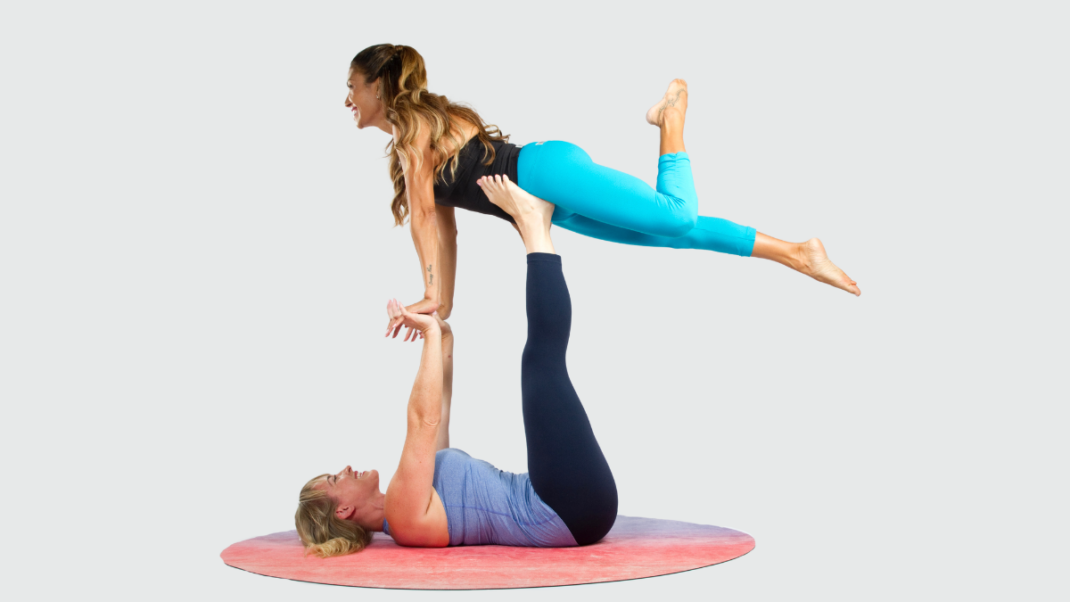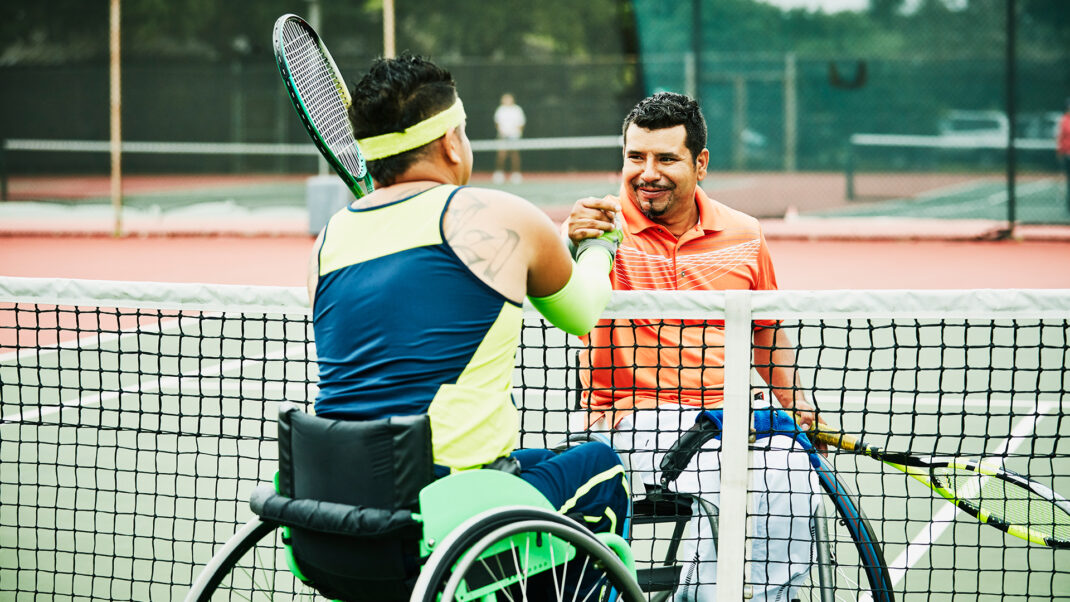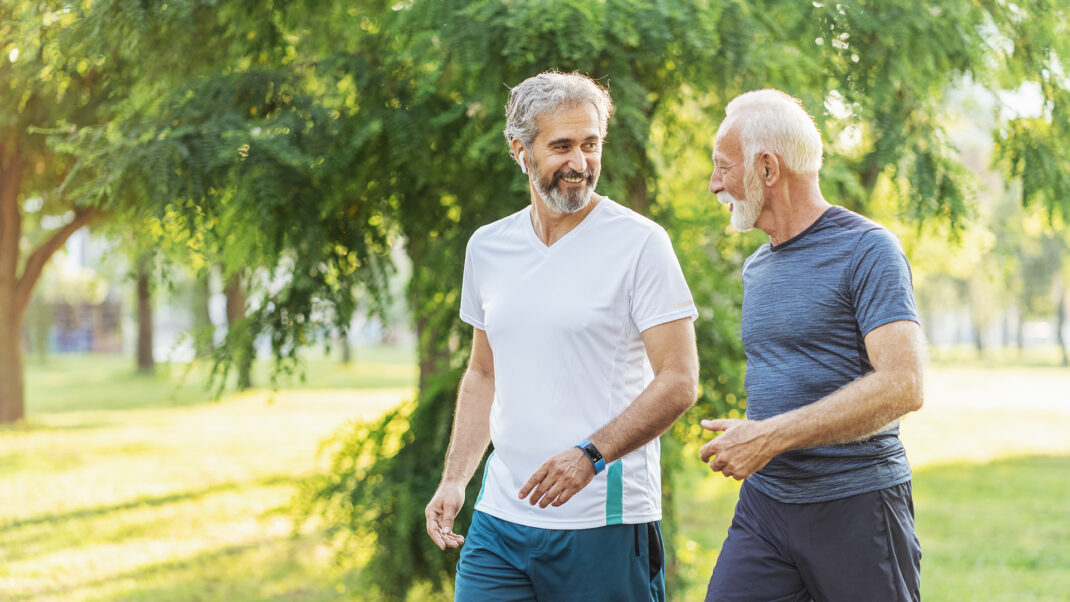What Type of Exercise Do You Use to Help Older Adults Prevent Falls?
Q&A.
While a complete strength training, stability and cardiovascular regimen is needed for fall prevention, here are some exercises that will help.
Leg strength is crucial, and replicating daily movement patterns is useful. Squats (dumbbell or barbell) are ideal. Also look into bench squats to develop strength and power through the ankle, knee, hip and spine simultaneously. Leg curls and Romanian deadlifts are another big piece of the pie when developing leg strength; they bring more attention to the (somewhat undertrained) hamstring group.
But the key for many of my clients is training the lower body one leg at a time. Rarely is the lower body equally dispersing the workload (think about a walking stride). So I tie in single-leg balance (static and dynamic) activities, single-leg squats and single-leg Romanian deadlifts, as well as high-knee marching, lateral tube walking and multiplanar step-ups.
Corrective posture is also a variable to consider. Many older participants are kyphotic and/or have weak posterior scapular strength (causing their shoulders to appear rolled forward). Scapular protraction/retraction activities, shrugs, rows, pronated-grip pull-downs and rotator cuff exercises are useful here.
Note: Exercises will vary according to individual client health Rx, exercise Rx, capabilities and fitness level.
Don Bahneman, MS, CSCS
Fitness and Spa Director,
John’s Island Club
Vero Beach, Florida
My preference is to take a comprehensive yet individualized approach to fall prevention. This approach begins with assessing the client’s risk factors (including medical conditions, medication usage and fall history) as well as performing some physical measurements. Balance control is by nature multidimensional, and trainers should address each of those dimensions. It is important to address the client’s global areas of balance control and identify the main area(s) of deficit—the weak link(s) in the chain. Too often, trainers take a one-dimensional approach to balance training. There is a lot more to fall prevention than standing on one leg!
Assessment is vital because dysfunctions in the control mechanisms vary widely from client to client. Some items in the Senior Fitness Test battery are helpful for determining deficiencies and identifying clients at greater risk of falling. The 8-Foot Up-and-Go assesses mobility. It is also a great test for observing a client’s performance, which helps me see deficiencies. The 30-Second Chair Stand test gives me an idea of functional lower-body strength. The modified Clinical Test of Sensory Interaction on Balance allows me to assess sensory input, specifically vision, somatosensation and vestibular control. I sometimes use the Berg Balance Scale to assess overall balance performance (widely used in the research literature), although it is best suited for someone with lesser abilities, as there is a definite ceiling effect to this test. Assessing posture and gait mechanics is also helpful.
Once I have gathered this information, we begin working on a comprehensive program that includes basic strength, flexibility and endurance; gait enhancement; postural strategies (ankle, hip and step); multisensory training (vision, somatosensation and vestibular); and center-of-gravity control (much of it based on the Fallproof Program from California State University, Fullerton). The specific exercises match the individual’s current abilities in each of these areas and may progress from seated to standing and from stable to unstable surfaces. For example, center-of-gravity control may progress from seated leans in a chair to seated leans on a stability ball to standing static weight shifting to standing dynamic weight transfers to one of my favorite, more complex activities, “What Time Is It?”
For the exercise “What Time Is It?” the client stands in an open area and imagines she is in the middle of a huge clock face on the floor, facing the number 12. Therefore 3 will be to her immediate right, 6 behind and 9 to the immediate left. You call a time, such as 9 o’clock, and she needs to transfer weight toward that number. So in this example she would step with her left foot immediately to her left, completely transferring her weight onto her left leg and then returning to the beginning position. As clients get better at this exercise, you add intensity by giving them times in quicker succession so that they must step and return to the start swiftly and safely without losing their balance.
Cody Sipe, MS
2005 IDEA Program Director
of the Year
Co-owner, Miracles Fitness
West Lafayette, Indiana
A program that includes exercises for balance should contain movements that increase flexibility in the neck and torso; strengthen the lower body, ankle complex, quadriceps, arms, back and abdominals; force the client to weight-shift; gradually decrease his base of support; and go from a stable surface to an unstable surface.
A balance program should progress from a two-legged stance that minimally challenges stability to a more complex stance. The progression evolves in this manner:
- two-legged exercise with minimal challenge to stability
- staggered stance
- single-leg base of support
- two-legged exercise, unstable surface
- single-leg exercise, unstable surface
The arm progression goes as follows:
- two arms
- alternate arms
- one arm
- one arm with movement
After a client assessment and medical clearance, a program might contain some of the following exercises and stances:
Warm-Up
- walking forward and backward
- side to side/carioca
- walking forward and backward on heels/toes
- squats to single-leg balance
- step-ups, front/side
Head turns and arm movements can be added when the client is ready.
During the resistance work the client should begin with easy exercises and gradually progress to more challenging ones. Here, the easiest exercises are listed first on each line, followed by more challenging ones:
- standing on one leg, eyes open; standing on one leg, eyes closed
- two-legged wall ball squat; single-leg squat with reach
- prone dumbbell row on stability ball; single-leg cable row
- staggered-stance biceps curl; biceps curl standing on BOSU® Balance Trainer/DynaDisc®
- single-leg cable chest press; push-up on stability ball
- seated PNF (proprioceptive neuromuscular facilitation) on stability ball; seated PNF on ball with side reach
- cable triceps extension on stability ball; single-leg triceps kickback
- floor cobra; stability ball cobra
- floor supine bridge; single-leg floor bridge
- floor crunch; stability ball crunch
- forearm plank; ball plank
- heel raises on floor; heel raises on BOSU/DynaDisc
Using elements of balance in this manner keeps the client challenged and focused. It also allows the client to develop postural control, reducing the possibility of falls and injury.
Susan A. Gilmore, MS
Your Personal Best Inc.
Alexandria, Virginia
For those of us working with older adults, balance training has become a significant element of overall training protocol. Before I work with any client, I require a physician’s authorization plus the client’s informed consent, and then I complete a balance/fitness assessment. I use the Fullerton Advanced Balance Scale and the Senior Fitness Test.
Completing the balance assessment identifies the intrinsic risk factors causing the balance/fall problem. The assessment addresses muscle strength/endurance, flexibility and joint mobility, motor ability (balance, coordination, speed, agility, power), physical impairments, memory, vision, sensory capacity, hearing, neurological function and a medication review.
To identify extrinsic fall risk factors, I walk through the client’s living situation, noting loose carpeting, availability of railings, shoes/slippers, etc. If it is appropriate, I recommend a thorough assessment from an occupational therapist specializing in home safety. Most home safety assessments are covered by Medicare or the client’s insurance provider if they are done by an occupational therapist. There are also many good sites on the Web that can help with home safety concerns.
After doing an assessment and a walk-through, I create an appropriate fitness program based on the assessment results. I monitor successes and weaknesses, adjusting the program as needed every 8 weeks.
Balance training is a lot about building your client’s confidence and opening up neural pathways that lead to better balance and overall fitness. I am constantly challenging clients’ limits and abilities, while simultaneously maintaining a safe environment. In some cases I use a gait belt to preserve a safety margin while pushing a client to extend beyond his comfort zone.
Strength training, endurance and flexibility are incorporated into the overall balance workout in every session. For example, if I am working on leg strength and endurance, I may have a client power up a steep incline, working on long strides, building strength and endurance and improving walking skills (gait). Many older adults walk with a narrow base of support (small steps), thinking it will keep them safe. In fact, smaller steps provide a narrower base of support, resulting in a higher risk for falls. Note: Most balance training should be done within a safe environment near walls, with chairs for the client to hold onto if needed. Safety is number one when providing balance training.
Progress will be influenced by previous levels of motor skill experience and current levels of physical activity. During balance and fall prevention training, you should provide safety tips and feedback based on your observations of the client’s progress.
Many exercises and routines are helpful for balance training. Below is a list of the most common exercises I use when training clients. (Before a session, warm up the client to elevate the heart rate and prepare the muscles and joints for activity. Be mindful of hearing and vision challenges.)
- stepping up and down onto a 4- to 6-inch box
- weight shifting, tai chi
- upper-body strength training (so a client can get up off the floor if he does fall)
- “crossing the creek”—obstacle course
- stepping over obstacles
- single leg stand for 30 seconds or more
- side leg raises
- stepping strategies—walking with stops and starts, walking narrow and wide, walking with long strides
- lunges
- ball tosses on alternative surfaces; e.g., throwing a weighted ball while standing on an Airex balance pad
- alternative base of support (tandem with ball tosses)
- eyes open, eyes closed, on alternative base of support
Make sure you include walking exercises in every training session. Bring instability into each workout, within a safe environment, so the client has an opportunity to learn how to lose and regain balance. Know that not all clients can improve their balance; for some, the goal will be to keep what they have.
For more information, see www.stopfalls.org, a professional organization with the mission of educating healthcare professionals about fall prevention.
Linda Owen Cantrill
Balance and Mobility Specialist, CPT
Spirited Balance™
Los Angeles, California
I have found that all my older clients have a fear of falling and feel that they do not have great balance. Balance training truly enhances their stability and, if they practice the exercises, they feel more confident and regain that lost sense of control. Slow progression is the key to success.
Here are some of the best tips I know:
- Focus on posture. Keep the head centered, chin parallel to the floor, shoulders back and down away from the ears, chest lifted, hips and knees pointed forward and weight evenly distributed on both feet. Cue clients to think about squeezing a tennis ball between the shoulder blades.
- Focus on strengthening the muscles that surround the joints (ankles, knees and hips), especially the gluteals, as they are a major stabilizer for gait.
- Advise clients to wear a shoe that will give them proper support.
- Ask if clients are on any medications that may impact their balance.
- Make clients aware that bifocals can cause them to trip, especially when walking down stairs.
- Have clients practice the following exercises (tie them into everyday situations):
- heel raises
- braiding/lateral-grapevine moves
- walking a narrow path—heel to toe
- walk a narrow path with high knee lifts
- single-leg stance (eyes open then eyes closed)
- reactive training: small step out to side (mini squat) and back to center; small step forward (mini lunge) and back to center (This exercise imitates stepping off a curb and quickly coming back to the curb because a car is coming.)
- easy strength training exercises, like sitting down in a chair and standing up
- standing leg abduction
- toe taps: lifting the toe up to strengthen the anterior tibialis (This helps avoid tripping. Taps can be done straight up and down as well as in and out. Ask clients to do toe taps as homework and let them know they can be done anywhere.)
Focus on strength exercises that work muscles that are behind you.
Josie Gardiner
ACE, ACSM and AFAA Certified
2002 IDEA Instructor of the Year
2005 ACE Instructor of the Year
Boston, Massachusetts
I try to simulate real-life scenarios and think about the action and the muscles involved in that action. Some of the basics that I use to assess movement are the chair squat (squatting into a chair in a controlled manner with no hands and standing up without using hands) and the single-leg resistance-band squat (a single-leg squat into the chair holding onto the handles of a resistance band/tubing).
I focus on underactive muscles like the gluteus and abductors by having clients do lateral steps over step risers stacked according to the clients’ balance capabilities. I advance the exercise by having people hold a medicine ball in front of them while stepping.
I also have clients do the triangle-cone touch with hands or a mini soft ball. I set one cone about 12–18 inches in front of them and 2 cones laterally, one on each side about 6–8 inches in from the front cone, forming a triangle. (This exercise targets the hamstrings and the quadriceps as well as hitting the front and lateral delts with the front and side raises of the soft balls.) Clients put their lead foot about 3–6 inches from the side cones and place weight on the front foot. Keeping the back straight, they deadlift-touch the single front cone, come back up and single-leg squat the side cones. They can start by touching with the fingertips and then advance to using two soft medicine balls.
In addition, I like to do single-leg front heel taps, side toe taps and reverse toe taps, all with one leg and tapping anywhere from 7 to 10 times in succession. These exercises target the quads, glutes and abductors.
I also teach walking balance steps. While walking, clients balance 2–3 seconds on one leg before advancing to the other foot. They must not fall into the step. I ask clients to exaggerate the stride, forcing more stabilization so as to work the core. These steps also work the quads and strengthen the calf muscles.
In split-leg helicopter rotations, the legs are in a slight lunge position and the arms are extended out to the side with palms down. Clients perform rotation with the head following the body as far to one side as possible and then rotate back to center. The helicopter rotations focus on working the obliques and stabilizing the entire core structure.
Kim Miller
NASM-Certified Personal Trainer
Owner, Fittkixx Health and Wellness
Owner, FITT4U
Greenville, South Carolina



